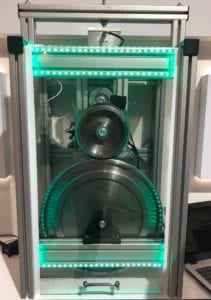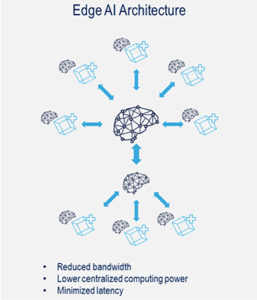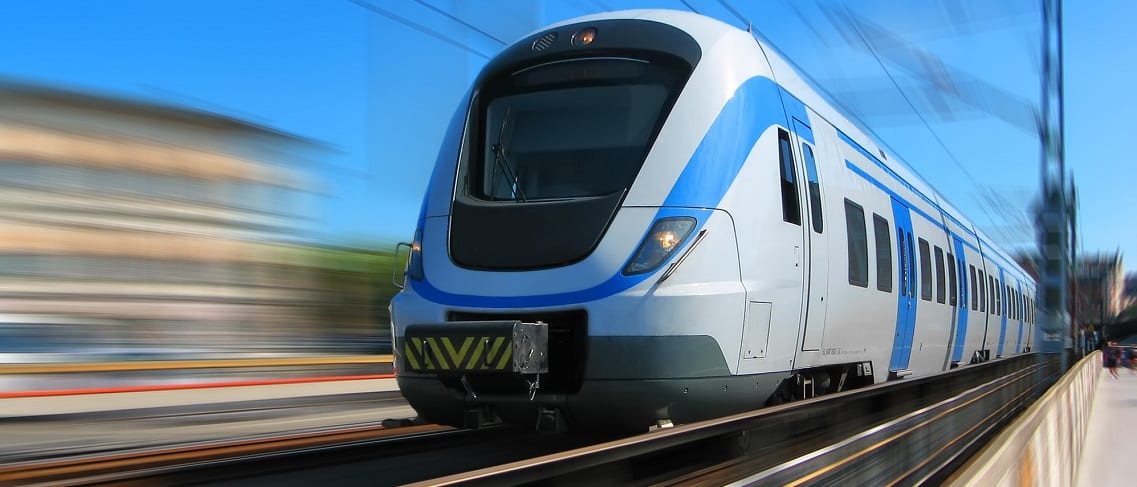At ST we believe that Artificial Intelligence (AI) has a bright future in a wide variety of industrial applications. That is why we were delighted to be present at Electronica 2018 together with Lenord + Bauer to jointly present an example of AI in industrial sensor systems, with a use case for vibration analysis in trains.
Smart Sensing for Railway Carriages
 The intelligent sensor used by Lenord + Bauer is based on an accelerometer and STM32 microcontroller from ST packaged in an evaluation board (STEVAL-BFA001V1B). The sensor is designed to be attached to a train wheel bogie (undercarriage) and has embedded AI to detect damage or material fatigue at an early stage. The Neural Networks embedded in the STM32 microcontroller have been trained with pre-processed data acquired from the integrated sensor on a test bench and automatically converted into an optimized code for the microcontroller thanks to a highly efficient tool – the STM32Cube.AI. This software tool, which is fully integrated into STM32 SW ecosystem as part of the widely-used STM32CubeMX tool, allows fast, automatic conversion of pre-trained Neural Networks into optimized libraries that can run on any STM32 Cortex-M-based MCU. The STM32CubeMX with STM32Cube.AI is available to alpha customers since October 2018 and will be broadly available in Q1 2019.
The intelligent sensor used by Lenord + Bauer is based on an accelerometer and STM32 microcontroller from ST packaged in an evaluation board (STEVAL-BFA001V1B). The sensor is designed to be attached to a train wheel bogie (undercarriage) and has embedded AI to detect damage or material fatigue at an early stage. The Neural Networks embedded in the STM32 microcontroller have been trained with pre-processed data acquired from the integrated sensor on a test bench and automatically converted into an optimized code for the microcontroller thanks to a highly efficient tool – the STM32Cube.AI. This software tool, which is fully integrated into STM32 SW ecosystem as part of the widely-used STM32CubeMX tool, allows fast, automatic conversion of pre-trained Neural Networks into optimized libraries that can run on any STM32 Cortex-M-based MCU. The STM32CubeMX with STM32Cube.AI is available to alpha customers since October 2018 and will be broadly available in Q1 2019.
The AI Advantage
Artificial Intelligence (AI) can be defined as a machine’s ability to perform logical analysis, acquire knowledge, and adapt to an environment that varies over time or in a given situation. AI is already widely used today in circumstances where a large amount of labeled, well-conditioned data sets is available and has been used mainly to process image and voice. Now, AI is finding more and more use in other applications, especially in the industrial domain.
AI offers an alternative to handcrafted rule-based programming by which engineers create detailed algorithms specifying every analytical step of the process. AI allows machines to “learn” from available data, either in supervised or unsupervised modes, and develop their own way of analyzing data and arriving at a result. The result of the “learning” process is distilled down into a “Neural Network” – a mathematical construct that works similar to the way the human brain works. The Neural Network embodies the knowledge acquired in the training to infer data features from new incoming data.
AI on the Edge For Smart Industry
 Smart Industry initiatives like those related to industrial automation, predictive maintenance, and more intelligent working environments are creating opportunities to use AI as part of smart sensor systems. Condition Monitoring and Predictive Maintenance systems are made up of a number of sensor nodes connected via a network to an Edge server or to a cloud service. If the raw data from each sensor is sent to a cloud server then this can require large bandwidth and induce latency issues if a fast response is required. A smart alternative is to process the data directly on smart sensor nodes using embedded AI-powered analytics. This minimizes the bandwidth for data that needs to be transmitted over the network and allows fast reaction.
Smart Industry initiatives like those related to industrial automation, predictive maintenance, and more intelligent working environments are creating opportunities to use AI as part of smart sensor systems. Condition Monitoring and Predictive Maintenance systems are made up of a number of sensor nodes connected via a network to an Edge server or to a cloud service. If the raw data from each sensor is sent to a cloud server then this can require large bandwidth and induce latency issues if a fast response is required. A smart alternative is to process the data directly on smart sensor nodes using embedded AI-powered analytics. This minimizes the bandwidth for data that needs to be transmitted over the network and allows fast reaction.
A smart sensor node generally contains a microcontroller that provides local data processing capabilities including data capture, processing, and communication handling. The microcontroller executes the AI algorithms usually involving both time domain and frequency spectrum analysis, as well as other processing to clean sensor data and set precise alarm thresholds.
A particular advantage of AI in these nodes is that if the physical elements being monitored change by, for example, replacing one machine with another, then a new Neural Network can be generated quickly by acquiring new data and running it through the machine learning process before reloading it onto the smart sensor MCU. This is highly relevant for industrial environments where every machine could have different characteristics that need to be taken into account when creating a monitoring program, due to the machines’ nature and age. The handcrafted algorithm approach here would require much more time and effort and is not scalable to different machines and machine types.
Unexpected Benefits
There is another less obvious advantage. Consider the trains with the Lenord + Bauer intelligent sensors; with this AI-based technology, these trains themselves become sensors, too. They can monitor and provide data that describe the conditions of the tracks they run on. As trains travel their routes, they produce information that can be mapped to a location and synchronized from multiple trains to encourage predictive maintenance on sections of rail that may be weakening structurally—before failure.
With so many direct and secondary benefits, AI will certainly find broad application in a wide variety of Industrial Applications – and many others.
Lenord + Bauer is an internationally active specialist for motion sensors and integrated drive technology. The company develops, produces and distributes solutions for the transport industry, with focus on railways, and motion automation, particularly tools and packaging machine applications.
